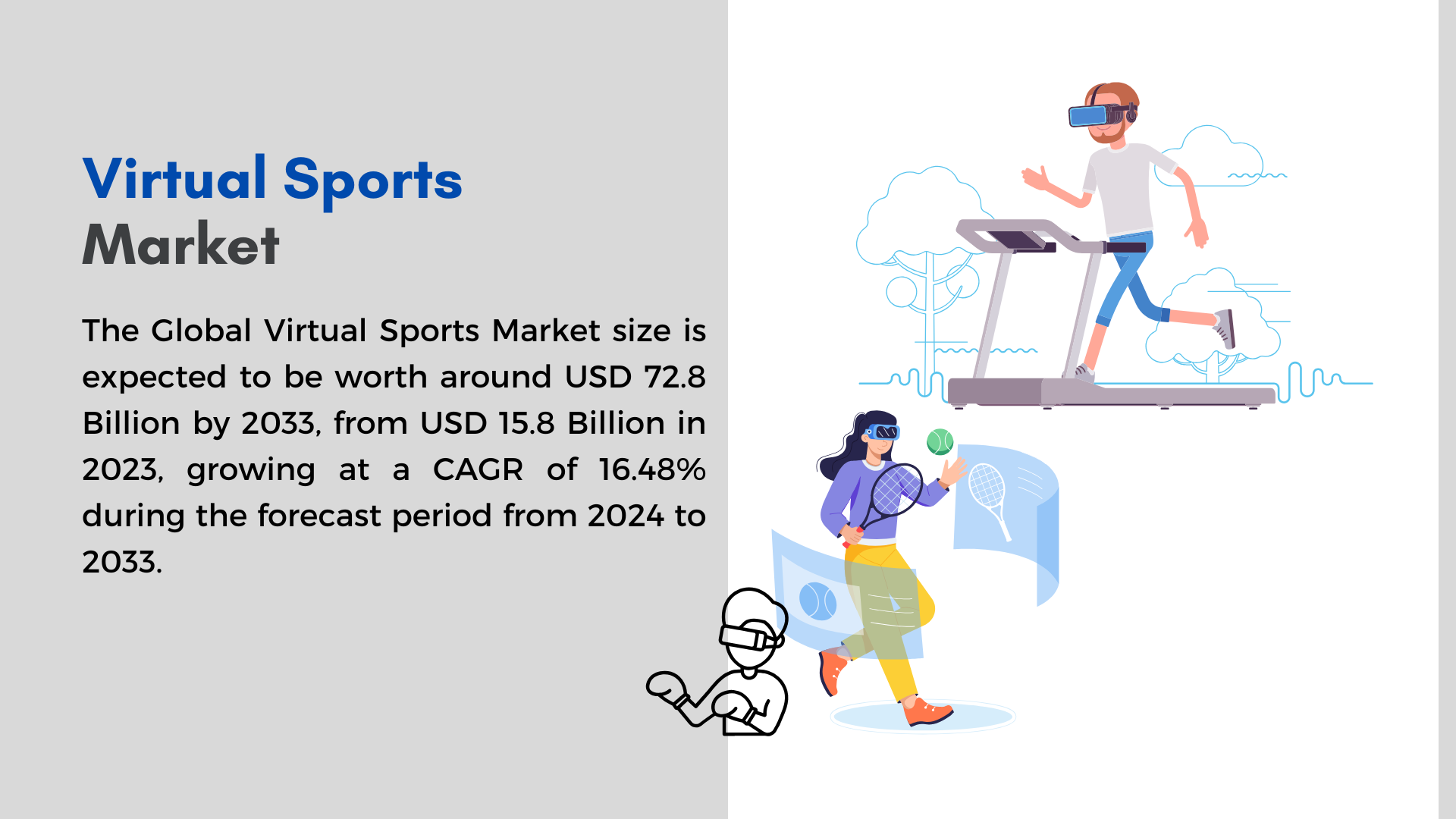Introduction
According to the research conducted by Market.us, The Global Virtual Sports Market is set to witness robust growth, projected to reach USD 72.8 billion by 2033, up from USD 15.8 billion in 2023, at a CAGR of 16.48% during the forecast period. In 2023, North America held a prominent position, accounting for over 28% of the market share. The demand for virtual sports in the region was valued at USD 4.4 billion, with expectations of substantial growth in the coming years.
Virtual sports are simulated sporting events created using computer graphics and algorithms. These digital games are based on real-life sports like soccer, horse racing, or basketball. The outcomes are determined by a computer algorithm, often using a random number generator. Virtual sports provide continuous betting opportunities and entertainment, regardless of real-world sports schedules, making them popular in online betting platforms.
The virtual sports market is a segment within the digital entertainment and online betting industries. It includes the development, distribution, and operation of virtual sports betting platforms. This market caters to online casinos, betting shops, and individual bettors seeking instant betting opportunities. It has gained popularity due to its ability to offer continuous betting options, especially when live sports events are off-season or cancelled.

The growth of the virtual sports market is driven by advancements in graphical and simulation technologies that make the games more realistic and engaging. The global expansion of internet access and the increasing adoption of smartphones also contribute to the wider reach and accessibility of virtual sports betting platforms. Additionally, the legal regularization of online betting in various countries has opened up new markets for virtual sports.
Market demand for virtual sports is fueled by the convenience of quick and continuous betting opportunities that appeal to both avid sports fans and casual bettors. Virtual sports are not bound by real-world schedules, allowing operators to offer games around the clock, which is particularly appealing in regions where live sports betting is limited by time zones or seasonal disruptions.
Opportunities in the virtual sports market include the integration of emerging technologies like VR (virtual reality) and AR (augmented reality) to enhance user experience. There’s also potential in expanding into new geographic regions where online betting is becoming legalized. Partnerships with sports betting companies and online casinos can further expand reach and operational capabilities.
The market is set to expand as consumer behavior shifts toward more interactive and digital forms of entertainment. The continuous innovation in gaming technology and the integration of AI for more realistic simulations are likely to attract a broader audience. Moreover, as regulations evolve, new markets will open up, providing further growth opportunities for operators in the virtual sports sector.
Key Takeaways
- The Global Virtual Sports Market is projected to achieve an impressive value of USD 72.8 billion by 2033, growing at a compounded annual growth rate (CAGR) of 16.48% over the next decade. This growth trajectory underscores the market’s dynamic nature and its rapid expansion within the digital entertainment sector.
- The introduction and proliferation of 5G technology are set to play a pivotal role in this market’s evolution, enhancing live streaming capabilities significantly. It is anticipated that live streaming capacities will increase by more than 25% with 5G compared to the current 4G networks, which promises to elevate the user experience and boost user engagement substantially.
- In terms of market segments, the Solutions segment emerged as the clear leader in 2023, claiming over 86% of the market share. The dominance of this segment is largely due to the escalating demand for high-quality virtual sports experiences, propelled by continuous advancements in gaming technologies and graphics.
- Football remains the most popular sport within the virtual sports arena, holding more than 27% of the game type market share in 2023. The sport’s widespread global appeal and the industry’s ability to offer realistic, engaging simulations of football matches contribute to this segment’s prominence.
- The demographic of 21 to 34 years old is the most significant consumer base for virtual sports, accounting for more than 42% of the market share in 2023. This group’s familiarity and comfort with digital technology, combined with their keen interest in gaming, position them as the primary audience for virtual sports products.
- Geographically, North America continues to lead the global market, with a market share exceeding 28% in 2023. The region’s strong technological infrastructure and the high adoption rate of digital entertainment options facilitate this leading position.
Virtual Sports Statistics
- According to Thrivemyway, virtual bets predominantly focus on popular games, with 80% of bets placed on FIFA and NBA 2K games.
- BetConstruct reports conducting over 3,200 virtual games and matches daily.
- In the UK, virtual sports contribute to 3% to 5% of the total gambling revenue generated.
- The Online Betting Guide (OBG) noted a 943% surge in traffic since the onset of the pandemic, highlighting a significant increase in interest towards virtual sports betting.
- Puntforfree notes a 30% increase in virtual sports betting activity among ten leading European operators due to the pandemic.
- BetConstruct offers around 3,200 virtual sports matches per day.
- During the initial month of the sports crisis precipitated by COVID-19, over 50,000 virtual sports and esports matches were organized.
- Virtual sports betting generates 4% to 6% of the UK’s online gambling revenue.
- As per the latest insights from Market.us, AI in Sports Market size is projected to reach approximately USD 36.7 Billion by 2033, up from USD 2.6 Billion in 2023. This represents a significant growth with a CAGR of 30.3% during the forecast period from 2024 to 2033. Similarly, Esports Market is Expected to grow to around USD 16.7 billion by 2033, from USD 2.3 billion in 2023. The market is anticipated to expand at a CAGR of 21.9% from 2024 to 2033.
Emerging Trends
- Integration of Advanced Technologies: The virtual sports industry is rapidly embracing newer technologies like 5G, which significantly improves live streaming capabilities and enhances user engagement through better connectivity and faster data transfer rates.
- Increased Focus on Mobile Platforms: With the global increase in smartphone usage, virtual sports platforms are optimizing their games for mobile devices, making it easier for users to access games on the go.
- Expansion of Betting Options: The virtual sports betting market is expanding, incorporating more diverse betting options and simulations, making the betting experience more varied and engaging for users.
- Use of Virtual and Augmented Reality: Incorporating VR and AR technologies to provide more immersive experiences is becoming a common trend, allowing users to feel more involved in the virtual sports they play or bet on.
- Cross-Platform Integration: There is a growing trend towards creating virtual sports experiences that can be accessed across various platforms, from PCs to gaming consoles to mobile devices, ensuring a seamless user experience regardless of the device used.
Top Use Cases
- Online Betting: Virtual sports are heavily used in online betting, where users can wager on the outcomes of simulated sports events, which are quick and run continuously, allowing for frequent bets and fast outcomes.
- Skill Development and Training: Athletes and amateurs alike use virtual sports for training purposes, where they can simulate different scenarios and improve their skills without the physical limitations of the real world.
- Entertainment and Engagement: Virtual sports serve as a source of entertainment, offering various games like football, basketball, and racing, which keep users engaged with interactive gameplay and competitive elements.
- Social Interaction: These platforms often have multiplayer features that allow users to interact and compete with others, fostering a sense of community among users worldwide.
- Educational Tools: Virtual sports are also used as educational tools in schools and sports clubs to teach the rules and strategies of various sports, making learning more interactive and fun.
Major Challenges
- Technological Barriers: Despite rapid advancements, the virtual sports industry faces challenges with the integration of cutting-edge technologies like virtual reality and artificial intelligence. Ensuring seamless, realistic experiences requires continuous innovation, which can be resource-intensive.
- Legal and Regulatory Issues: Virtual sports operators often grapple with complex legal and regulatory environments, which vary widely across different regions. Navigating these can limit market entry and affect the deployment of virtual sports solutions.
- Perception and Engagement Issues: There’s a significant challenge in changing traditional sports fans’ perceptions to see virtual sports as a viable alternative. Additionally, maintaining user engagement amidst abundant entertainment choices remains critical.
- Competition from Traditional and Emerging Markets: Virtual sports must compete not only with traditional sports but also with rapidly growing sectors like eSports and online gaming, which can divert potential users and investment.
- Monetization Strategies: Developing effective monetization models is crucial yet challenging. While in-game advertising and sponsorships offer potential, converting free users into paying customers is an ongoing difficulty.
Top Opportunities
- Global Market Expansion: Virtual sports platforms can reach a global audience, breaking geographical barriers. This expansion is facilitated by the growing accessibility of internet services and digital devices worldwide.
- Diverse Revenue Streams: There are numerous avenues for revenue, including advertisements, partnerships, in-app purchases, and subscriptions. These can help sustain business growth and drive continuous innovation.
- Technological Innovations: Ongoing technological advancements offer significant opportunities to enhance user experiences. Innovations in AI, VR, and game physics can create more engaging and realistic virtual sports environments.
- Integration with Esports and Online Betting: Virtual sports are well-positioned to integrate with the burgeoning eSports industry and online betting platforms. This integration can lead to new business ventures and collaborations, expanding market reach and consumer base.
- Advancements in Interactive and Immersive Technologies: The use of advanced graphics, real-time streaming, and interactive features can significantly enhance user engagement, making virtual sports a more attractive option for the younger, tech-savvy generation.
Conclusion
The virtual sports market is set to grow significantly, driven by technological advancements and increasing global access to the internet and mobile devices. As virtual sports offer a flexible and engaging alternative to traditional sports betting, they meet the modern consumer’s demand for quick and accessible entertainment. With new opportunities emerging from technological innovations and regulatory changes, the market is poised for further expansion, making it an attractive area for investment and development in the digital entertainment industry.
